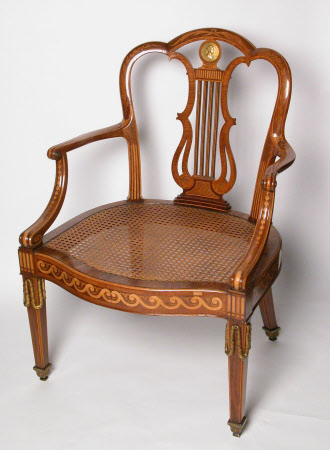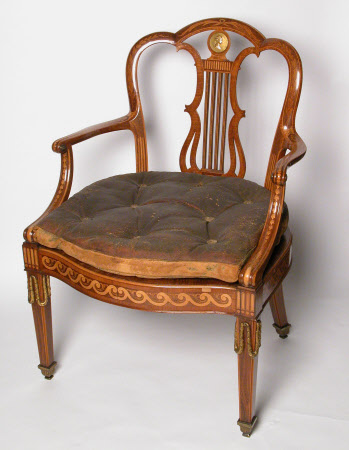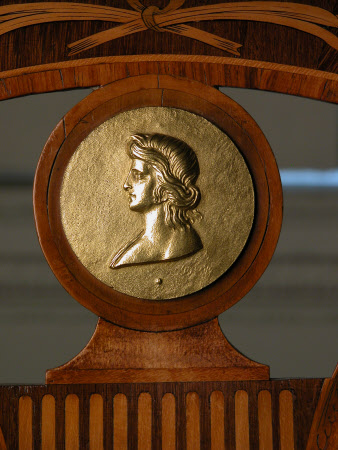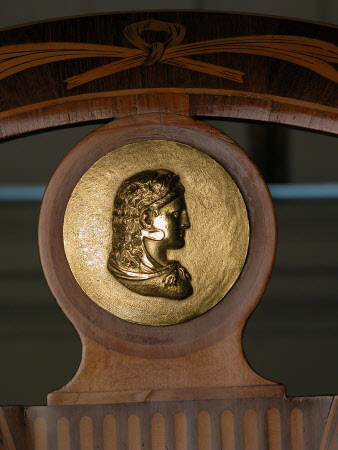Open armchair
possibly John Linnell (1729 - 1796)
Category
Furniture
Date
circa 1768
Materials
Mahogany, rosewood, satinwood, harewood, ormolu, cane
Measurements
89.5 x 63 x 51 cm
Place of origin
Berkeley Square
Order this imageCollection
Osterley Park and House, London
NT 771755.7
Summary
An open armchair, one of eight in the Library at Osterley Park, made circa 1768, possibly designed by and made in the workshop of John Linnell (1729-96), cabinet-maker of Berkeley Square, London, by Swedish-born Christopher Fuhrlohg (1740-87) and Georg Haupt (1741-84). The eight chairs in fact comprising two sets of four chairs of two slightly differering designs. Four of the chairs with an ormolu cameo bust facing to the left, and four with an ormoly cameo bust facing to the right. Each cameo of a different bust. Each having a toprail with two breaks in its curve forming three 'arches' and above a pierced lyre-shaped splat surmounted by a bronze cameo medallion. The arms open, outswept, scroll-ended and raised on curving supports either side of a cane lined seat with curved rear rail and serpentine front rail inlaid with a band of Vitruvian scrolls meeting and opposing at the centre. Raised on four tapering square-section legs (the rear legs set at a significant rake), the front legs headed by applied ormolu garlands or festoons, all terminating in bronze caps. Decorated throughout with very fine marquetry of crossed palms, husks, lines, flutes, sprays of leaves, and lines. Four chairs with an additional section of harewood inlay at the base of the splat and with slightly different scrolls to the arm supports.
Full description
Robert Adam’s (1728-92) designs for the Library at Osterley were drawn in 1766 and the room is thought to have been furnished around 1768-9. Because of the superiority of their marquetry, these chairs have been attributed to the Swedish-born cabinet-makers and inlayers Christopher Fuhrlohg (1740-87) and Georg Haupt (1741-84). Both men are thought to have worked for the cabinet-maker John Linnell (1729-96) at his workshop in Berkeley Square about that time. They had trained in Sweden, Amsterdam and Paris, and the decoration of these chairs is characteristic of France in the late 1760s, although the form of the chairs is English. Fuhrlohg, a particularly accomplished inlayer, worked at Linnell’s workshop between 1767 and 1769, and it is believed that Haupt joined him there in 1768. Both appear in a painting of the workshop executed by the Swedish painter Elias Martin (1739-1818). In 1769, Haupt was appointed cabinet-maker to the King of Sweden and returned home; Fuhrlohg remained in England and was eventually appointed cabinet-maker to the Prince of Wales. The chairs were made alongside a magnificent library table (NT 771753) and two writing tables (NT 771754.1 & .2) which also remain in the Library at Osterley Park. The chairs were listed in the inventory taken at Osterley in 1782 as ‘Eight Curious inlaid Elbow Chairs with Or Molee [sic: ormolu] Ornaments cane seats Cushions covered with green Leather and Serge Cases’ and in 1871 as ‘8 Rosewood Inlaid shaped back Arm Chairs w[ith] Cane Seats and ormolu mounts w[ith] Loose Stuffed Hair Cushions Covered in Green Leather and loose baize covers’. The cushions survive.
Makers and roles
possibly John Linnell (1729 - 1796), cabinetmaker possibly Christopher Fuhrlohg (c.1740 - c.1787), cabinetmaker possibly George Haupt (1741 - 1784), cabinetmaker possibly John Linnell (1729 - 1796), designer possibly Christopher Fuhrlohg (c.1740 - c.1787), inlayer possibly George Haupt (1741 - 1784), inlayer



